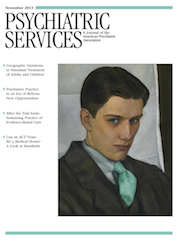The Enduring Mismatch Between Service Need and Use
High-value health care systems strive to match service use to need. Evidence accumulated over decades indicates that the U.S. mental health care system does not do a good job of matching service need and use, and unwarranted geographic variations in service use have been documented.
In this issue, McDonald and Jalbert report findings from a study that examined geographic variation in stimulant use among U.S. children and adolescents in 2008. The authors found wide variations in use as well as an overall rate of stimulant use that was lower than the estimated prevalence of attention-deficit hyperactivity disorder (ADHD). Although the authors lacked clinical information about participants and their findings may have been partly attributable to geographic differences in factors that they were unable to account for, such as availability of behavioral therapy and use of prior authorization by payers and health plans, their study is an important addition to the growing body of evidence of geographic variations in mental health care.
The authors caution readers not to conclude that regions with higher rates of stimulant use also had higher rates of appropriate ADHD care, and they review factors that might lead to stimulant overuse even in a setting of lower-than-expected overall stimulant use. In fact, it is entirely possible that underuse of stimulants among people with ADHD coexists with overuse by people for whom these medications offer little or no value, as well as misuse by people who abuse and become addicted to stimulants. Although more effective efforts to reduce undertreatment of ADHD are needed, the same is true for stimulant overuse and misuse, which may have substantially worsened since 2008.
Last spring, two New York Times reporters published their analysis of data from a CDC study of children’s health issues conducted between February 2011 and June 2012. The analysis showed a 16% increase since 2007 in the lifetime prevalence of ADHD among children and adolescents and a 41% rise in the past decade—a rise that several experts interviewed for the article considered to be indicative of overdiagnosis. Concerns with overuse and misuse of stimulants have grown with DSM-5 revisions to ADHD diagnostic criteria, particularly the replacement of the requirement that impairment-causing symptoms be present before age seven by the requirement that several inattentive or hyperactive-impulsive symptoms be present before age 12.
McDonald and Jalbert rightly state that disparities between recommended and actual care can be ameliorated through education and training interventions aimed at physicians. We should also develop the clinical competency of the nonphysician workforce, educate and support patients and their advocates, align the policy and regulatory environment with the overarching goal of improving value, and reduce the effect of commercial forces in health care.



